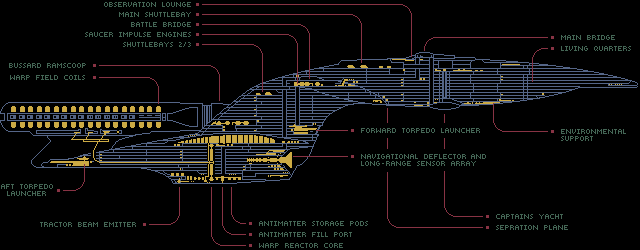


Type: Explorer/Battle
Commisioned: 2362 - Present
Length: 641m
Beam: 560m
Height: 145m
Decks: 42
Weight: 5,125,000 tons
The Galaxy class was developed to replace the ageing Ambassador and Oberth class starships as Starfleets
primary exploration vessel. The design was initiated in 2343 with a highly challenging specification which
called for a ship based on the Nebula design then being developed, but equally capable of scientific,
exploration, diplomatic, cultural, and combat roles all within a single multimission hull. In fact, many came
to regard the requirement as too challenging; the project suffered from numerous delays due to a wide
range of design, manufacturing, and construction problems. The first of the class, the USS Galaxy, was
launched in 2357 and commissioned in 2362, nearly two decades after initial approval.
The USS Galaxy which emerged from the Utopia Planitia shipyard had very similar lines to the Nebula class.
The Galaxy is some 15% larger in volume, although its less compact design gives it considerably greater
length than the smaller vessel. The major change between the two is the lack of a mission-specific pod on
the Galaxy class, the increased volume allowing sections within the hull to be mission customized. This
combined with a more advanced systems level to allow all functions to be performed by the single design.
In addition the saucer and engineering hulls are separated by an eleven deck connecting neck section. This
separation between the two hulls allows the nacelles to be located outboard and above the engineering
hull, a position which increases the efficiency of the warp drive field slightly. This gives the Galaxy class
warp coils an efficiency of 88% at speeds of up to Warp 7 and 52% through Warp 9.1 - the comparable
figures for the Nebula class are 84% and 47% respectively.
The increased internal volume allowed for 800,000 square metres of mission adaptable facilities. This
allows the Galaxy class to support a wide range of ongoing research projects independently of the vessels
primary mission. Although not a new idea in Starfleet vessels, the Galaxy class is unique in the extent to
which this is possible. These ships are capable of supporting up to 5,000 mission specialists, while the
decentralized nature of the secondary power grids allows laboratories to function effectively even during
combat operations.
The combat capability of the Galaxy class was also significantly greater than that of the Nebulas. The three
burst fire torpedo tubes are each capable of launching ten photon torpedoes every six seconds, while there
are no less than twelve Type X phaser arrays. As with many recent Federation designs, the use of long
phaser arrays rather than banks gives the main phasers of the Galaxy class a great capability for sustained
firing and rapid recharge/cool down time. The Galaxy class is the first on which all segments of every
phaser array are supplied by a separate power system; although this increases the complexity of the
system tremendously, it gives the phaser arrays a tremendous survivability in the face of combat damage.
In service the Galaxy class at first proved exemplary, but by 2371 no less than three of the initial six ships
had been lost, one with her entire complement of crew and families. This alarming record led to many
changes being introduced during refits of the remaining three vessels, and also to the construction of six
new Galaxy class ships from space frames held in reserve against future need. The unfortunate history of
the Galaxy class vessels combined with the recent escalation's in tensions within the alpha quadrant has
led to all six vessels being subsequently completed, and all are now on active service against the
Dominion.
Major changes to the Galaxy class have included a new more powerful warp core, a redesigned shield
system intended to perform far better against phased polaron beam weapons, various changes to the ships
computer systems, plus many minor changes to the ships systems. There are currently nine galaxy class
vessels in service. Production of these vessels continues today; five Galaxy class ships took part in the
recent operation to retake Deep Space Nine from the Dominion and the class has gained a fearsome
reputation during the war, so far operating without loss. Though new Galaxy class ships are being produced
without any science or diplomatic facilities included in order to reduce the vessel mass and so enhance
combat performance during the Dominion war. These ships will be "filled out" after the war, considerably
enhancing Starfleets exploration capacity. At this point further production is expected to be terminated in
favour of the new Sovereign class.
